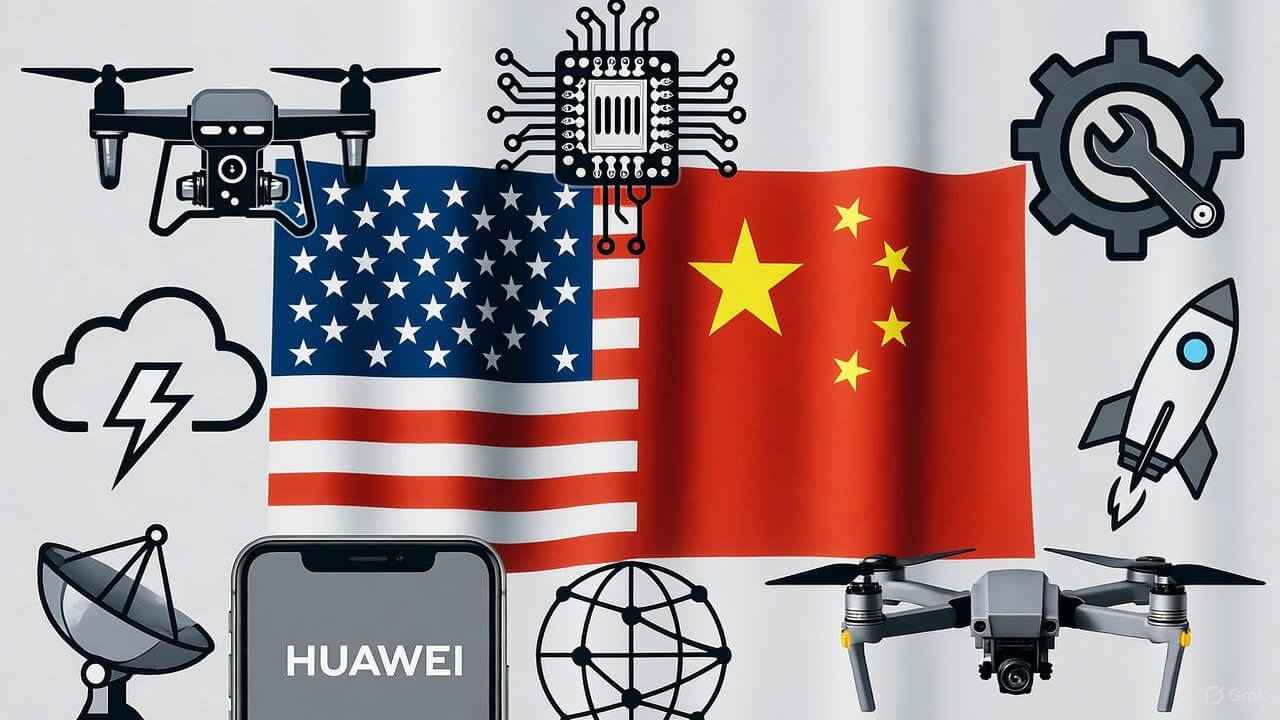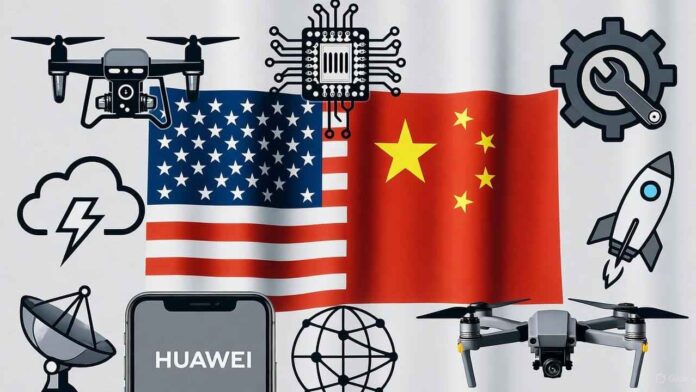
New US export restrictions on Chinese tech firms like Huawei and DJI escalate US China relations tensions, closing loopholes and sparking Beijing’s fury.
Table of Contents
Hey there, have you heard the latest buzz in global tech? The Trump administration just dropped a bombshell by expanding export restrictions on Chinese technology companies. This move targets subsidiaries of firms already on the US Entity List, like Huawei and DJI, to plug up loopholes that let them skirt around bans. It’s all about keeping advanced US tech out of hands that could threaten national security. But Beijing isn’t taking it lightly—they’ve slammed it as “extremely malicious” and promised countermeasures.
In this post, we’ll dive deep into what’s happening and why it matters for US China relations. You’ll learn about the new rules, how they hit big players in technology, the economic ripple effects with real stats, and what this means for the future. We’ll break it down simply, with examples like Huawei’s past struggles and DJI’s drone dominance. By the end, you’ll see how these export restrictions are heating up the tech cold war between the two superpowers. Stick around—it’s more than just policy; it could change how we all use gadgets daily. And if you’re in tech or business, this affects you. Let’s get into it.
https://bharatdiaries.com/kantara-chapter-1-a-cinematic-revolution-in-epic-storytelling/
What Are the New Export Restrictions?
The US Commerce Department rolled out a new rule on September 29, 2025, that widens the net of its Entity List. This list blocks certain foreign companies from getting US tech without special approval. Now, it automatically includes subsidiaries of listed firms, no questions asked.
Before, companies could set up new arms or affiliates to dodge the bans. Not anymore. This change aims to stop that trickery cold.
Why Did the US Do This?
It’s all about national security. The US worries that Chinese firms could use American tech for military gains or spying. Think chips for AI or drones for surveillance.
The rule covers tens of thousands of entities worldwide, but China feels the heat most. It’s part of a bigger push under Trump to curb China’s tech rise.
How Do These Restrictions Work?
- Licensing Needed: Firms must get US permission to export controlled items like semiconductors or software.
- Broader Reach: Subsidiaries anywhere get hit if the parent is listed.
- Compliance Burden: Businesses now have to check deeper into supply chains to avoid fines.
This isn’t new—export restrictions started ramping up in 2018—but this tweak closes big gaps.
Key Companies Affected: Huawei and DJI
Huawei and DJI are front and center in this storm. Let’s look at each.
Huawei’s Ongoing Battle
Huawei, a telecom giant, has been on the Entity List since 2019. It lost access to Google services and US chips, tanking its smartphone sales by over 80% in some markets.
Now, with subsidiaries targeted, Huawei’s global ops get squeezed more. For example, its cloud arm might struggle to buy servers with US parts.
A case study: In 2020, Huawei stockpiled chips before bans hit. Sales dropped from $136 billion in 2019 to $99 billion in 2021. But it bounced back some by making its own tech, like Kirin chips.
DJI’s Drone Dominance Under Threat
DJI controls about 70% of the global drone market. It’s used for everything from farming to filmmaking.
The new rules could block DJI subsidiaries from US cameras or sensors. In the US, lawmakers already push to ban DJI drones over data security fears.
Example: In 2024, the US House passed a bill to ground DJI drones federally. This export move amps that up, potentially cutting DJI’s revenue by 20-30% if suppliers bail.
Other firms like YMTC (memory chips) and Hikvision (surveillance) face similar hits.
Beijing’s Strong Reaction to the Move
Beijing didn’t hold back. China’s Commerce Ministry called the US action “extremely malicious” and a blow to fair trade.
They vowed to “take necessary measures” to protect Chinese firms. That could mean retaliatory bans on US exports.
Past Responses from China
China has hit back before. In 2023, it restricted rare earth exports key for US tech. In April 2025, it tightened controls on rare earth magnets.
Stats show China’s response boosts its own innovation. Affected firms ramped R&D spending by 16.6% on average after US bans.
This tit-for-tat is straining US-China relations further.
The Broader Impact on Technology and Global Supply Chains
These export restrictions ripple far. They disrupt global tech flows and force companies to pick sides.
Economic Hits: Stats and Examples
US firms lose big too. Export controls cut US semiconductor sales to China by 20-30% in some sectors.
China’s tech sector grew slower, but it poured $50 billion into domestic chips in 2024 alone.
A comparison table:
| Aspect | Before Restrictions (Pre-2018) | After Recent Expansions (2025) |
|---|---|---|
| Huawei Revenue | $100B+ annually | Dropped to $99B in 2021, recovering to $120B by 2024 with homegrown tech |
| DJI Market Share | 80% global | Could fall to 50-60% if bans spread |
| China R&D Spend | 10-15% of revenue | Up 16.6% post-bans |
| US Exports to China | $20B in semis | Down 25%, per industry reports |
This shows how bans hurt both sides but push China to self-reliance.
Supply Chain Shifts
Companies like Apple and Tesla are moving production out of China. Vietnam and India gain.
Bullet points on impacts:
- Higher Costs: Firms spend more on compliance checks.
- Innovation Boost: China files 40% more AI patents since 2020.
- Global Tension: Allies like Japan join US controls, isolating China more.
Relatable example: Your next smartphone might cost more if chip shortages hit due to these rules.
A History of US China Relation Tech Tensions
US China relations in tech didn’t sour overnight. It started heating up in 2017.
Early Sparks: Trade Wars Begin
Trump’s first term slapped tariffs on $300B of Chinese goods. China hit back with its own.
By 2018, Huawei probes over IP theft kicked off bans.
Escalation in the 2020s
2022 saw broad chip export controls. Expanded in 2023-2024.
Recent developments: In August 2025, talks on AI chips, but no deal. Now, this subsidiary rule in September.
Step-by-step timeline:
- 2017: Tariffs start.
- 2019: Huawei on Entity List.
- 2022: AI/semiconductor bans.
- 2025: Subsidiaries included.
This history shows a pattern: Each move ups the ante in US China relations.
What This Means for the Future of US China Relations
Looking ahead, these restrictions could lead to a full tech decoupling.
China might ban more US firms or hoard resources like rare earths.
For businesses, it’s riskier to operate in both markets.
But there’s hope—talks could ease tensions if Trump and Xi meet.
In US China relations, tech is now the battleground. It affects jobs, innovation, and even consumer prices.
FAQ: Common Questions on US China Relations and Export Restrictions
What are the new US export restrictions on Chinese technology?
They expand the Entity List to auto-include subsidiaries, targeting firms like Huawei and DJI to stop loophole use.
How do these affect Huawei and DJI?
Huawei faces tighter chip access; DJI could lose drone parts, hurting market share.
Why is Beijing angry about these technology bans?
They see it as unfair bullying that harms global trade and their companies.
What impact do export restrictions have on global technology?
They raise costs, boost China’s self-reliance, and disrupt supply chains worldwide.
How have US China relations evolved in tech?
From trade wars in 2017 to full bans now, it’s a escalating rivalry.
Will these restrictions end soon?
Unlikely without talks; they might get tougher under ongoing tensions.
Conclusion
To wrap up, the new US export restrictions on Chinese tech subsidiaries are a big escalation in US China relations. They target loopholes, hitting Huawei, DJI, and others hard, while sparking Beijing’s wrath. We’ve seen the history, impacts with stats like 16.6% R&D jumps in China, and future risks of decoupling.
This isn’t just policy—it’s reshaping tech for everyone. If you’re following US China relations, stay tuned for more twists.
What do you think? Will this lead to a trade deal or more fights? Drop a comment below, share this post, or subscribe for updates on global tech news. Your thoughts could spark great discussion!
